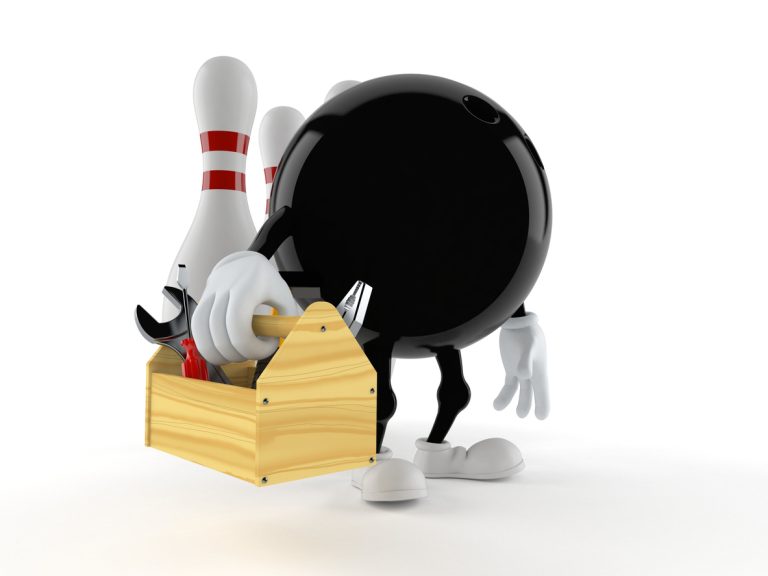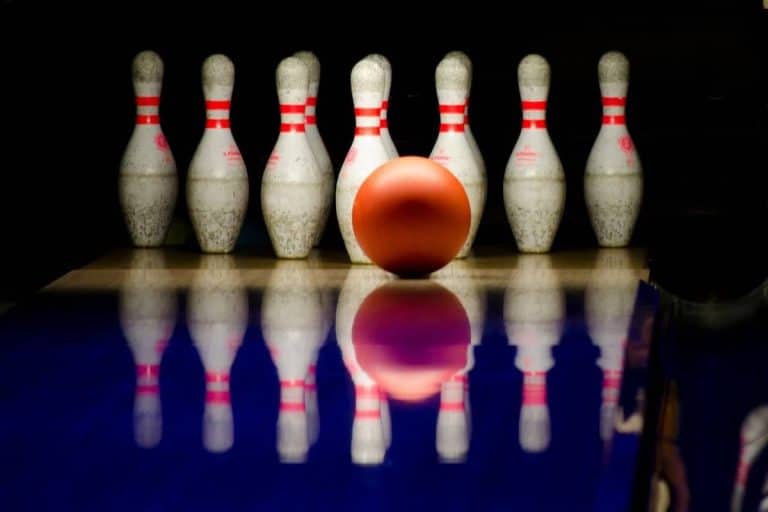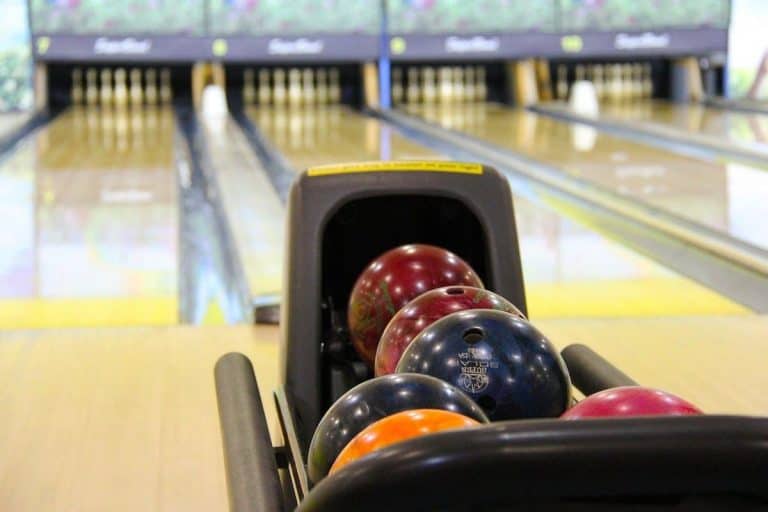You Can Redrill a Bowling Ball – But Should You?
If you’ve ever seen a bowling ball come off a production line, you’ll notice that it is a perfectly smooth sphere with no holes drilled in it. The finger holes haven’t been drilled yet and are made once the spec of the ball is determined.
The drilling sets the position and depth of the finger holes in the ball depending on where the ball will be used. The holes are usually drilled to the knuckle as a standard alley-issue ball used for recreational bowlers. For Pro Bowlers, these holes would be custom drilled to suit the player.
What does redrilling do? How is it done, and what is the benefit of redrilling the ball? Let’s take a look at the processes involved with redrilling a bowling ball.
Can You Redrill A Bowling Ball?
The simple answer is yes, very much so. This is a common practice in bowling, so much so that it wouldn’t be unusual to find more drilled and plugged bowling balls on the rack at a league game or a tournament than non-plugged balls!
Redrilling involves first filling up or ‘plugging’ the existing holes and then redrilling the holes to suit the grip of the ball’s owner.
How Does Redrilling Work?
This is a relatively simple process and involves plugging the existing holes with an epoxy resin-type product, then redrilling the holes to suit the new owner or required configuration.
There are many filler-type products available, and depending on whether you do this as a DIY project or take it to your PSO, the process will be pretty much the same.
A word here on DIY projects. This is not something to be undertaken lightly, as doing this wrong could result in the ball being damaged or cracking the coverstock, in which case you’d need to replace it.
Once the holes are plugged and sanded smooth, the new measurements for the hand configuration are marked. There are three standard hand positions on a bowling ball.
The conventional grip is achieved by drilling the holes, so the fingers and thumb fit in up to the second knuckle joint. This is the position for beginners and recreational bowlers and is the one you’ll find most on alley standard balls.
The second position is the fingertip grip, where the fingers and thumb fit into the first knuckle. This is the position commonly seen for more advanced and skilled bowlers. It’s harder to control but allows for more lift and spin and is the recommended configuration for the hook shot.
The semi-fingertip grip is the hybrid between the first two positions, allowing the finger and thumb to fit the first and second knuckle. This is easier to master than the fingertip grip and is probably a good balance between control and skill. This type of grip would be used for intermediate-level players.
While there are other grip configurations like the Sarge Easter grip, these are the most common.
Why Would You Redrill A Ball In The First Place?
The number one reason to redrill a ball is to achieve better performance or repair a cracked bridge.
Bowlers would primarily consider redrilling because they have bought a second-hand ball, and the grip configuration doesn’t suit them. Or they need to change the grip configuration of their existing ball as they have improved and are looking to start achieving more control and spin on their shots.
With the number of available second-hand balls on the market found on platforms such as Craiglist, eBay, Facebook Marketplace, and others, this market is massive. It offers bowlers a wide variety of balls at reasonable prices.
Finding a ball with the closest configuration to your existing ball is the best option, but buying online is not always possible. The good news is that it will be cheaper to redrill the ball than to buy a new one.
Redrilling Vs. New Costs
Taking your ball to your nearest PSO to have it redrilled is probably the easiest, simplest, and the least risky option to have your ball properly redrilled. They will have all the tools and materials to do the job properly
While this would be between $40 and $60, the cost of a new ball would be from $150 and upwards. Also, having your PSO do it reduces the risk of damage to the coverstock and will ensure that the new holes are correctly and accurately measured and aligned to your hands and grip.
Before the ball is drilled, the PSO inspects the coverstock and checks any cracks or chips before starting. They also need to make sure that the ball can withstand the process and that its weight is legal before redrilling.
The coverstock needs to be restored to its original condition- or as close to it as possible – and then the ball will be plugged before drilling.
Remember that redrilling a ball can remove around 1-2 ounces of weight from it, so making sure of the weight beforehand is always a good idea.
It’s also an excellent plan to chat to your PSO or the person who will be doing the work on your ball and explain why you want the ball redrilled and the results you expect to get out of it, making sure the ball isn’t is in good enough condition.
If the layout on the ball is going to work for you and all you really need to do is plug the thumb or fingers to change the span and then go with the slug rather than the plug. It’s always better to use the least invasive option.
How Many Times Can You Redrill a Ball
Constant redrilling a ball is not recommended as this will eventually result in the coverstock cracking and core damage. If this happens, your balling ball would be rendered useless, and you’d have to then look at buying another one.
Once the core structure of the ball has been altered, it cannot be restored, and the ball will never be the same again. Then you’d be stuck with a dead ball and need to either buy another new or second-hand one.
If you consider the cost to do this at your PSO, it may be cheaper to buy a new one instead of redrilling and plugging the ball time and again.
While there is no actual set number of times you can redrill and plug a ball, you probably don’t want to do it too often as your ball will then resemble a large Swiss Cheese!
DIY Redrilling and Plugging
Suppose you are confident in your ability and have the suitable materials, drilling, and measuring equipment (sandpaper of various grits, putty, the drills, and vice, as well as the resin). In that case, you could do this at home.
One of the most significant considerations is that you need to know where the bowling ball core is, as if you don’t, you could ruin the ball for life. Removing part of the core would change the shape of the weight block, and from there, your ball would never perform the same again.
DIY redrilling is not recommended as the risk of damaging the coverstock or drilling incorrectly far outweighs the cost of having it done professionally.
Does Redrilling Affect the Performance of the Ball?
The effects on the ball performance would be hardly noticeable unless the holes have been drilled deeper than usual or if more mass has been removed from the ball’s core. If this was the case, then you may experience some ball motion variance.
Also, the proliferation of redrilled and plugged bowling balls is extensive, and as such, if this process had severe effects on performance, it wouldn’t be recommended or done on the scale that it is.
In fact, in most cases where the results required have been discussed and the proper process followed, bowlers are generally happy with the performance results they see. Remember, this is all about achieving better performance with the ball and scoring better as a result.
Because the coverstock and surface are restored before redrilling, the effect of contact with the lane by the plugged areas is negligible.
Having said all of this, any time you drill a ball, this will affect the core one way or another, but the effects would be negligible.
Even with redrilling and plugging, one other point to remember is that you still need to maintain the surface condition of the ball with regular cleaning and bleeding when the ball becomes greasy and loses its ‘tackiness’ over time due to oil build up.
One other point to remember about redrilling and plugging. If you do this within the first year after purchasing a new ball, plugging the ball would void the warranty so unless you absolutely have to, choose a ball that would not require this for at least the first 12 months of its life.
A few years ago, the materials used sometimes caused issues with cracking as if they had not cured properly before applying, there would be a weakness in the material structure and the bond to the ball.
The modern materials are much more robust, and while there is a slight variance in consistency where the plugged material molds to the ball, the chances of cracking under stress are virtually nil.
One last point on plugged balls. Try not to leave the ball in any place where the temperature could rise substantially, like a hot car, for example. Bowling balls plug materials can be susceptible to separation under high heat, so don’t leave your ball in your car when it’s 100 degrees outside.
If you are looking at a second-hand ball and you can see that the ball has been plugged, check to see whether you can see if the weight block of the ball has been compromised in any way. You can do this by looking directly into the hole
If the ball had already been plugged , you would have no way of knowing how deep that hole went and whether it affected the weight block. It’s advisable in this case to avoid the ball altogether as you have no way of knowing how the performance has been affected.
Besides Redrilling and Plugging, What Else Can You Do?
One of the drawbacks of redrilling and plugging is that you need to wait a while before using it again. One of the alternative options is to focus on the coverstock instead of opting for ‘surgery’ on your ball.
The first step is to resurface the bowling ball coverstock. This process offers some tangible results in terms of performance and is a lot cheaper and quicker than redrilling. By altering the texture of the surface, you can extend the ball skid length, and by doing so, increase the back end reaction.
Alternatively, this can decrease the back-end reaction by reducing the skid length. The PSO would screen the ball surface and apply new grit pads to generate more or less traction on the lane, depending on what is required.
This process produces similar results to the redrilling and plugging process and is cheaper and less risky, and would save time and money. Following a disciplined and consistent maintenance schedule of your ball surface will provide consistency in performance.
However, if you have bought a second-hand ball or need to change your grip to achieve better performance as your skill levels grow, you need to look at the redrilling and plugging of your ball.
Do You Need to Redrill and Plug Your Ball?
If you are buying a new ball, then take the time to have extensive discussions with your PSO, detail the performance results you are looking for, and let them guide you to the correct ball choice.
Going this way will get you the proper layout from the start, and then you won’t need to make any alterations further down the line. This will save you money and eliminate any usage delays caused by waiting for your ball to be usable after redrilling or plugging.
If you are buying a second-hand ball, whether it’s for your spare or strike ball, again take the time to have the ball evaluated by your PSO (where possible) or get as much info from the seller about the ball before buying and then get an opinion from your PSO on the information received.
As stated before, most second-hand balls have been redrilled and plugged, and unless you trust the person you are buying from, there is a risk of getting a ball that is not quite everything it’s been made out to be.
While it may seem a good idea to play around with all redrilling on your ball, the real question is, do you need to do this at your level?
Evaluate your status quo thoroughly around your current performance and get some proper advice as to where improvements can be made with technique and execution before looking to make alterations to the ball itself.
Bowling, as with other sports (like golf), is a discipline where players often look to change the tools of their trade rather than improving the mechanics of execution to achieve better results.
While redrilling and plugging the ball has some obvious and practical benefits when it comes to layout and grip options, the fewer alterations you can do to your ball, the better- especially for the ball!







